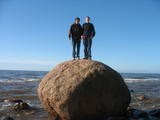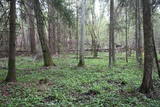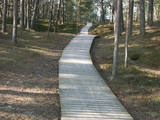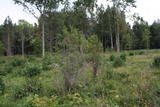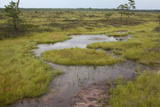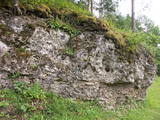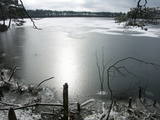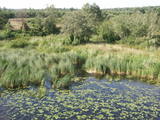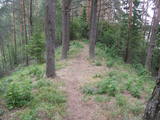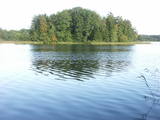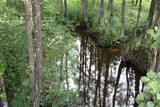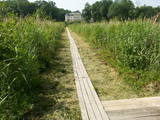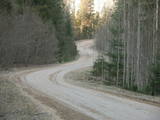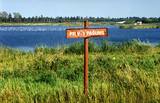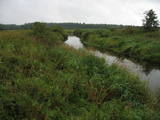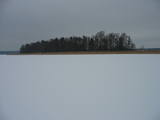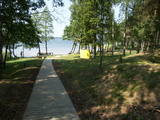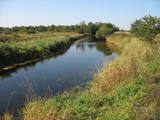| Nr | Name | Beschreibung |
|---|---|---|
|
Bedeckt mit Findlingen und mit kleinen Landspitzen und Buchten – dies ist die Ostküste der Bucht von Riga und das einzige Gebiet in Lettland, wo Sansteinaufschlüsse zu finden sind. Diese sind das Resultat der abschleifenden Wirkung der Wellen zwischen Tūja und Vitrupe. Die eindrucksvollsten Aufschlüsse haben die Veczemi – Felsen, die etwas weniger als einen halben Kilometer lang und bis zu 4 m hoch sind. Dieses Gebiet wurde touristisch verbessert. Man muss sagen, dass sich dieser Teil der Küste sehr oft ändert, besonders nach großen Stürmen.
|
||
|
One of the rare places (see also Rucavas ivju audze) in Latvia where two rare and protected wild tree species grow - yew-tree and Baltic ivy. Territory is not marked on site with information signs or stands therefore it is hard for visitors to find. Not usable as tourism object.
|
||
|
Dieses Territorium schützt die Biotope der Küstendünen und der Dünen von Plieņciems, die sich über die ganze Strecke bis nach Ķesterciems erstrecken. Das ist ein vielbesuchtes Gebiet, aber das Objekt Plieņciems wurde nicht ausgebaut. Es gibt jedoch einen hölzernen Fußweg durch die Düne zwischen Plieņciems und Ķesterciems. Hier wurde auch ein Erholungsgebiet errichtet.
|
||
|
One of few places in Latvia (around 1 km to the North from Lapmezciems) where used to be beautiful juniper meadows. Since no agriculture activity (grass cutting, cattle grazing) has been implemented in the area, juniper meadows are overgrowing and disappearing. To save the area sustainable management is needed. Slitere National Park with Blue Mountain cliff and Slitere lighthouse is located in short distance from Kadiku nora (Juniper meadow).
|
||
|
Very wide territory for a nature restricted area where extensive forests and several bogs can be found. The territory is important living space for many bird species. Vasenieku bog path with observation tower is the most attractive sites of the restricted area and offers unique landscape of the bog for its visitors. Waterproof shoes are recommended for visitors as the first 500 m of the path is molded turf rampart. Information stands are significant source of information along the path. It is suggested to visit also Stikli (Glass) village where glass factory used to be. Chandelier of Stende church has been made in this factory (by memory of Inese Roze).
|
||
|
Das ist ein Abschnitt des Gauja – Flusses mit Stromschnellen an einigen Stellen. Es erstreckt sich von Vidaga bis zum Ort, wo der Fluss Vecpalsa indie Gauja fließt. Entlang der Gauja und seinen Nebenflüssen kann man Dolomitaufschlüsse an seinen Ufern sehen, die größten sind die Randati – Klippen. Das Territorium wurde vor allem eingerichtet, um die verschiedenen Arten an Wald, Wiesen, Aufschlüssen und ihre Habitate zu schützen. Das ist ein interessanter Abschnitt des zentralen Teils der Gauja, vor allem für Leute, die die schöne Landschaft genießen möchten und für Wassertouristen.
|
||
|
Relatīvi grūti pieejama un cilvēka mazskarta teritorija kūdrā izstrādātajā Cenas tīreļa ziemeļaustrumu daļā, kur saglabājušies augstā purva biotopi ar purva ezeriem, kas kopumā veido nozīmīgu vietu ligzdojošām un migrējošām zosveidīgo, tārtiņveidīgo u.c. putnu sugām. Teritorija nav piemērota (un nav vēlams) tūrisma aktivitātēm.
|
||
|
Dieses Gebiet wird regelmäßig überflutet, wenn der Fluß Lielupe über seine Ufer tritt. Diese Auenwiesen sind wichtig für Vögel. Das Gebiet kann von der Straße Rīga-Liepāja und von der Straße nach Kalnciems aus, die daran entlang führen, betrachtet werden.
|
||
|
Das ist ein anderer sogenannter Berg aus der Eiszeit - fünf Kilometer lang und 15 bis 50 m hoch mit Hügelketten und Abhängen. Der ausgeprägteste Teil des Berges kann man zwischen den Seen Pinti und Šeški sehen. Die Kiefernwälder auf den Hügeln sind Habitat mit vielen seltenen und geschützten Arten. Ein Pfad ist eingerichtet worden, um den Grebļa – Berg und die Berge Āža und Kausu zu überqueren, aber es wird den besuchern enpfohlen, das in Begleitung eines kundigen Führers zu tun. Die biologische Vielfalt des Gebiete wird einem klarer, wenn man zum Beispiel erfährt, daß es mehr als 500 Arten an Schmetterlingen in diesem Schutzgebiet gibt.
|
||
|
Dieses Terrotorium schützt den See Jumurda, der sich im zentralen Teil des Vidzemer Hochlandes befindet, mit seinen drei Inseln, dem lokalen Laubwald und den umgebenden Landschaften.
|
||
|
Dieses Gebiet befindet sich auf beiden Seiten des mittleren Abschnitts des Flusses Raķupe. An den Ufern des Flusses gibt es sowohl viele verschiedene Wiesenbiotope als auch mächtige Eichen. Das ist ein wichtiger Platz für seltene Pflanzen und Tiere.
|
||
|
Der beste Platz, um sich das Schutzgebiet des Vīķi – Sumpfes, in dessen Zentrum sich der Lielauce – See befindet, anzuschauen, ist die Lielauce – Burg, wo ein hölzerner Plankenweg beginnt. Der Pfad leitet den Besucher durch die sumpfigen Ufer des Lielauce – Sees zu einem offenen Teil des Sees, wo man Boot fahren kann. Der Sumpf selbst befindet sich im südöstlichen Teil des Sees. Das Schutzgebiet wurde eingerichtet, um die Biotope und Arten in dem Gebiet zu schützen.
|
||
|
Dieses Gebiet ist kleiner als die Großen Kangari – Berge, ungefähr 10 km lang und 16 m hoch. Es befindet in der Nähe des Buļļi – Sumpfes. Das Territorium soll die Struktur, den Sumpf und die verschiedenen Waldarten und seltenen Pflanzen, die es in diesem Gebiet gibt, schützen.
|
||
|
Das ist eine ungewöhnliche Landschaft mit einem geschützten Biotop – der Binnendüne mit Silbergraswiesen und Wäldern mit Laubbäumen, einschließlich der Hainbuche. Touristen können den heiligen Fluss Muiža (Lejas) am rechten Ufer des Sventāja – Tales besuchen . Hier werden sie Lettlands prächtigste Traubenkirschbäume finden. Eine Pergola aus Blättern hat sich über dem Fluß gebildet.
|
||
|
Palieņu pļavas starp Rūjienu un Rūjas ieteku Burtnieku ezerā, kurām raksturīga liela augu un putnu sugu daudzveidība. Tās robežojas ar bijušiem Rūjas zivju dīķiem, kas šobrīd aizaug ar mežu. Rūjas palienes var vērot gan braucot ar laivu pa Rūju, gan arī no ceļa, kas ved uz minētajiem dīķiem. Tur izvietots informācijas stends.
|
||
|
Atrodas Cenas tīreļa dabas takas sākumā. No tā labi pārskatāma kūdrā izstrādātā Cenas tīreļa neliela daļa. |
||
|
Es gibt sechs Inseln im Großen Baltezers – See – die Inseln Auzu, Priežu, Mazā, Liepu, Ropažu und Meldru. Sie zeichnen sich durch eine große Pflanzenvielfalt aus, einschließlich Laubbäumen, Schwarzerlen und Kiefern. Das Territorium kann ganz gut von der Seite der lutherischen Kirche Ādaži aus betrachtet werden. Der Große Baltezers – See ist ein beliebter Ort zum Angeln, einschließlich Eisangeln während des Winters.
|
||
|
Ein mannigfaltiger Waldbestand, der durch die Vidzemer Straße und die Eisenbahnlinie Rīga-Lugaži halbiert ist. Das ist das Gebiet, in dem der am meisten gefährdete Vogel der Welt – die Blauracke – gefunden wird. Zwischen ¼ und 1/5 des lettischen Bestandes an Krähen findet man hier. Es ist auch eines der letzten Nistgebiete des Grünspechtes.
|
||
|
Dort befindet sich ein kleines Gebiet auf der Westseite des Sees Būšnieks, das eingerichtet wurde, um den Sumpfbiotop und die seltenen Pflanzen zu schützen. Gut ausgestattete Erholungseinrichtungen befinden sich am gegenüberliegenden Ufer des Sees.
|
||
|
Palieņu un mitrās pļavas abos Dubnas upes krastos, kuras nelielā posmā var vērot no Rožupes - Vārkavas ceļa. Piemērotā laikā šeit dzirdēsiet griezes balsi, kas ir Eiropā izzūdoša putnu suga.
|
||
